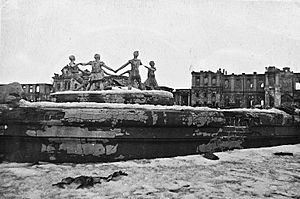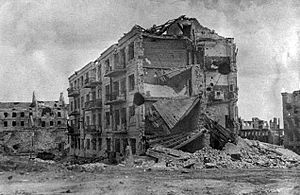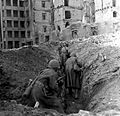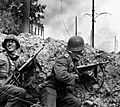Battle of Stalingrad facts for kids
Quick facts for kids Battle of Stalingrad |
|||||||||
|---|---|---|---|---|---|---|---|---|---|
| Part of the Eastern Front of World War II | |||||||||
 The Barmaley Fountain, one of the symbols of Stalingrad, in 1943, right after the battle |
|||||||||
|
|||||||||
| Belligerents | |||||||||
| Commanders and leaders | |||||||||
|
|
||||||||
| Strength | |||||||||
Initial:
|
Initial:
|
||||||||
| Casualties and losses | |||||||||
|
|
||||||||
The Battle of Stalingrad was a huge and very important fight during World War II. It happened between Nazi Germany and the Soviet Union in the city of Stalingrad. This battle lasted from August 23, 1942, to February 2, 1943.
It was one of the most brutal battles in history. Soldiers and civilians in Stalingrad faced terrible conditions. They sometimes had to eat rats because supplies were so low.
Stalingrad was a key city on the Volga River. It was important for factories and as a transport route. Adolf Hitler, the leader of Germany, also wanted to capture it. This was because it was named after Joseph Stalin, the Soviet leader. Taking the city would have been a big blow to Stalin.
Contents
Why the Battle of Stalingrad Was Important
The Battle of Stalingrad was a turning point in World War II. It stopped Germany's advances into the Soviet Union. After this battle, Germany's army was much weaker. Hitler himself later said that Stalingrad was a big reason for his defeat.
The Fight for Stalingrad Begins
In June 1942, Adolf Hitler launched a major attack in southern Russia. By the end of July, the German army had reached Stalingrad. German planes, called the Luftwaffe, bombed the city heavily. They turned most of it into ruins.
However, the destroyed buildings and rubble created many hiding spots. Russian snipers used these spots to attack the Germans. Both Hitler and Stalin sent huge numbers of soldiers to the city. They both gave strict orders: any soldier who tried to retreat would face severe punishment.
The Soviet Counterattack and German Surrender
On November 19, 1942, the Soviet army, also known as the Red Army, launched a surprise attack. They managed to surround the German forces in Stalingrad. Hitler ordered his army to stay and fight, even though they were trapped.
The German air force tried to drop supplies to the trapped soldiers from the air. But it wasn't enough. By February 1943, the German forces in Stalingrad ran out of ammunition and food. Many soldiers were freezing. Instead of fighting to the end, they surrendered.
The battle lasted for five months, one week, and three days. About 2 million people were killed or wounded. More Soviet soldiers died than German soldiers. However, it was a huge victory for the Soviets. They had caused so many losses to the German army that Hitler's plan to conquer the Soviet Union was seriously weakened. Also, the Germans failed to capture the important Russian oil fields.
Some Russian volunteers, called HIWIs, fought as part of the German army.
Interesting Facts About the Battle
- The Battle of Stalingrad is known as one of the largest and deadliest battles in history. Around 2,000,000 people were killed or wounded.
- Much of the fighting happened in the streets and inside buildings.
- Most of the city was destroyed by the German air force.
- The events of the Battle of Stalingrad have been shown in several films. These movies were made by German, Russian, British, and American filmmakers.
- In the book The Book Thief, one character was thought to have died or been captured during the Battle of Stalingrad.
- Adolf Hitler was very angry when German General Friedrich Paulus surrendered.
- While Friedrich Paulus was held captive by the Soviets, he made radio broadcasts. He told German soldiers not to fight for the Nazi government and to stop following Hitler.
- About 40,000 civilians also died during the battle.
- The battle lasted just over five months.
Images for kids
-
The German advance to the Don River between 7 May and 23 July
-
Smoke over the city center after aerial bombing by the German Luftwaffe on the central station
-
October 1942: A German soldier with a Soviet PPSh-41 submachine gun in Barrikady factory rubble
-
Soviet marines landing on the west bank of the Volga River
-
Soviet soldiers in the Red October Factory
-
Junkers Ju 87 Stuka dive bombers above the burning city
-
General Andrey Yeryomenko (right) with Nikita Khrushchev (left), Chief Commissar of the Stalingrad Front, December 1942
-
Commander-in-chief of the Don Front The Stalingrad Master General Konstantin Rokossovsky
See also
 In Spanish: Batalla de Stalingrado para niños
In Spanish: Batalla de Stalingrado para niños



































